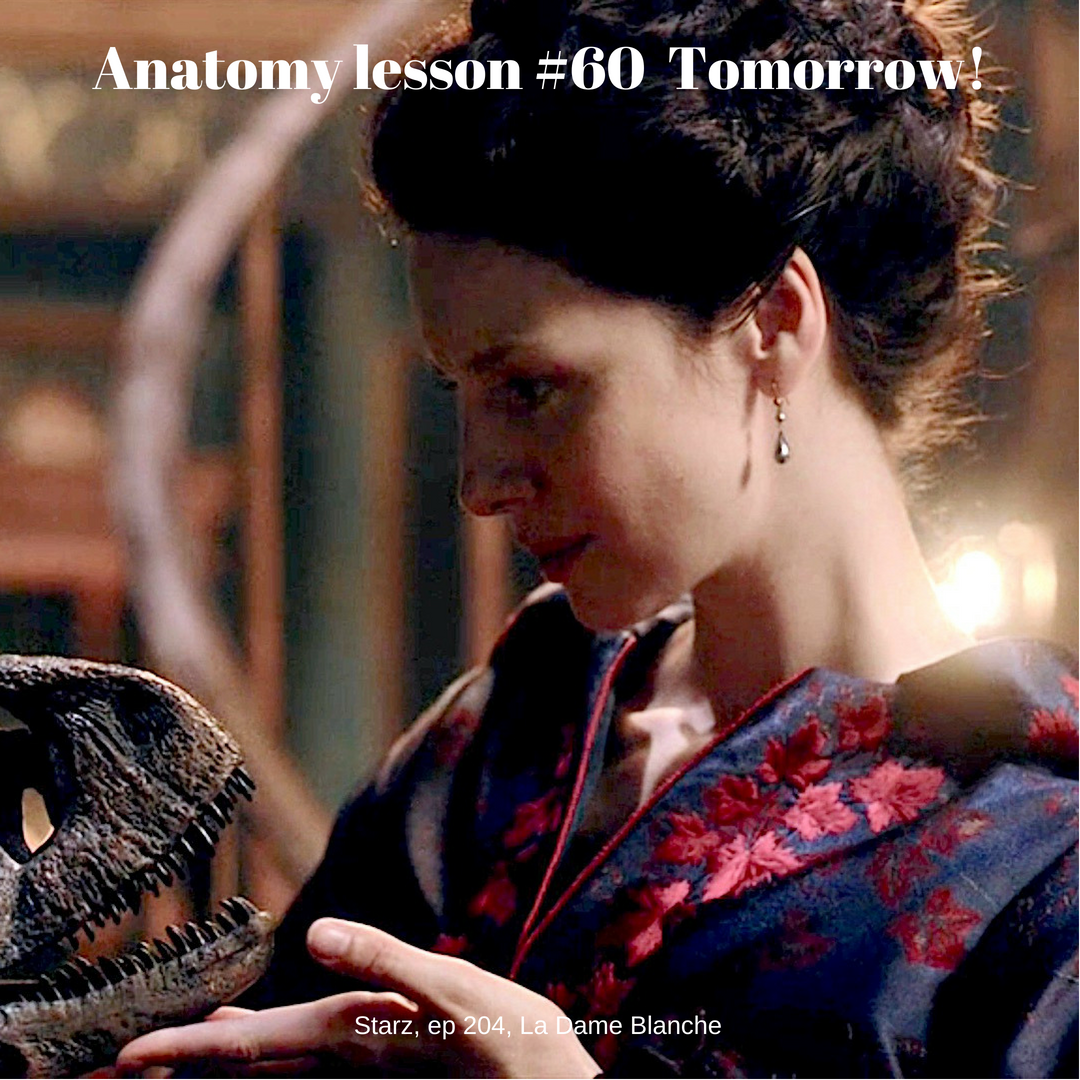
Let’s Mull the Skull tomorrow in Anatomy Lesson #60!
A deeply grateful,
Outlander Anatomist

Human Anatomy taught through the lens of the Outlander books by Diana Gabaldon and the Starz television series

Let’s Mull the Skull tomorrow in Anatomy Lesson #60!
A deeply grateful,
Outlander Anatomist
Do you have happy feet (ouch to these!)? Anatomy Lesson #59, Sweet Feet is Tomorrow!
The deeply grateful,
Outlander Anatomist
Follow me on:
Good day, anatomy students! Welcome to Anatomy Lesson #57, Fergus and the Phantom Limb.
Several readers have requested today’s topic… an exploration of the consequences of the fateful encounter twixt Fergus and Corporal MacGregor – Starz ep 302, Surrender
Warning! Readers may find a few images in this lesson a bit unsettling. But, rest assured, if you watched ep 302, you have seen the iffy images before. Also, this lesson must contain some neuroscience which, because of its complexity, is a challenge. Thus, explanations are distilled to bare essentials so all may understand. Hope this works for every reader!
Now, for the record, who is Corporal MacGregor (Ryan Fletcher)? Not a Voyager book character, this man is an invention by TV writer Anne Kenney and team: a Lowland Scot who identifies more with the English than fellow Highlanders. He takes an instant dislike to Lallybroch and its denizens – threatening little Jamie with a back-hand slap and disparaging Fergus as a –
filthy frog eater… Mind your tongue or I’ll cut it out!
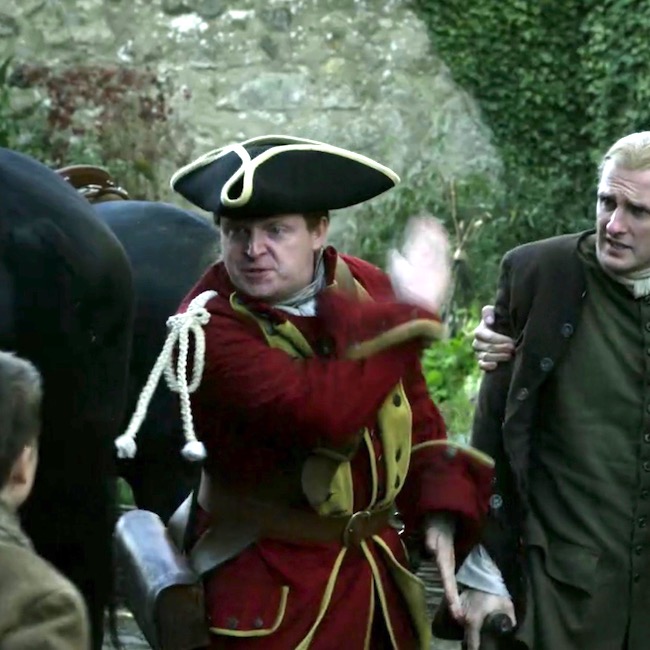
After repeat visits and more Redcoat insults, including crass threats to new mum, Jenny, Fergus leads Corporal MacGregor and pal on a taunt-jaunt. Soon, Fergus is trapped and the Low-lifer, erm, Lowlander, advances with a grimace and drawn blade!

A volley of yells, a brief struggle, a flash of the sword and… the unbelievable! Fergus’ clever hand with its nimble fingers is gone! From Voyager book, we share Jamie’s disbelief:
The shouting ceased abruptly in shocked silence. He scarcely heard when it resumed; it sounded so much like the roaring in his ears. His knees gave way, and he realized dimly that he was about to faint. His vision darkened into reddish black, shot with stars and streaks of light—

And more sad words from Voyager book to describe the horrific event:
…but not even the encroaching dark would blot out the final sight of Fergus’s hand, that small and deft and clever pickpocket’s hand, lying still in the mud of the track, palm turned upward in supplication.

In the TV version, Jamie rushes to the rescue, applying a pressure bandage to end of Fergus’ forearm, followed by a belt tourniquet. Jamie knows the drill, having watched his white woman deal with similar wounds of war. (Psst… in Voyager book, the Redcoats have the decency to return Fergus to Lallybroch)
Why, oh, why didn’t Jamie intervene to alter Fergus’ Fate? In emotional agony, he declares to his sib:
I should have stopped them!
Never one to mince words, TV Jenny tells it true:
Then ye’d be dead and so would he. We’d all be dead!

Jenny uses her own hard-earned wisdom derived from Ian’s leg loss to mend and attend Fergus’ stump.
Later, sitting up, but preferring French wine to Scotch whisky, Fergus tells Jamie “In one stroke, I have become a man of leisure!” Translation: Jamie must heed his Paris pledge to support a maimed Fergus for the rest of his life!
Jamie asks if it hurts, and Fergus answers that the wound:
Hurts a bit. Sometimes, it feels warm or scratchy or hurts like it is still there.
Later, Ian reassures Jamie:
My leg. It’s not there as anyone can plainly see. And, yet, it pains me terrible.
So, how is it that Ian’s missing leg stills pains him and how can Fergus still feel a hand left behind on the forest floor?
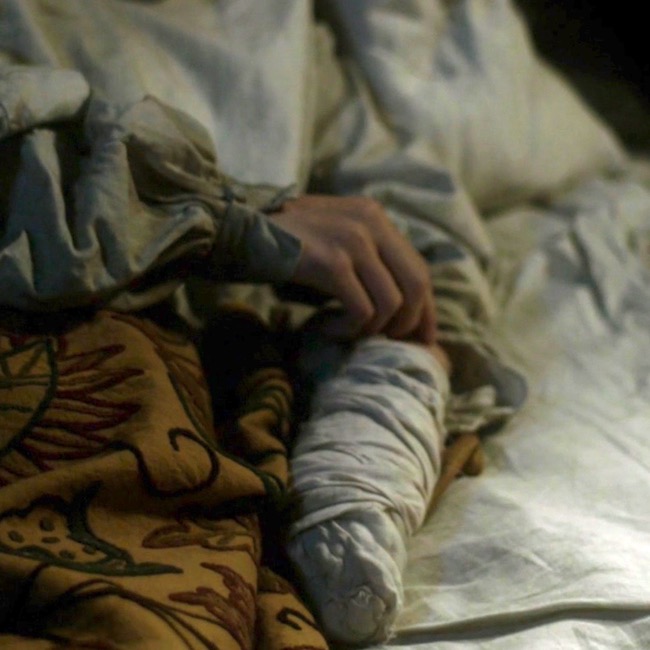
Anatomy Lesson to the rescue!
Phantom Limb Syndrome (PLS): Fergus and Ian describe sensations known as Phantom limb syndrome or PLS. PLS is the feeling that a lost limb is still present. Some 60 to 80% of amputees experience the sensation of an amputated limb and/or lost digits still being attached (Image A). Even people born with an absent limb or digit can experience PLS.
Interestingly, although PLS refers to the loss of a limb (and/or digits), some people report phantom sensation following the loss of other body parts such as breast, eye, nose, tongue, bowel, urinary bladder, or male phallus! Yes, they can perceive such missing parts as if still present!
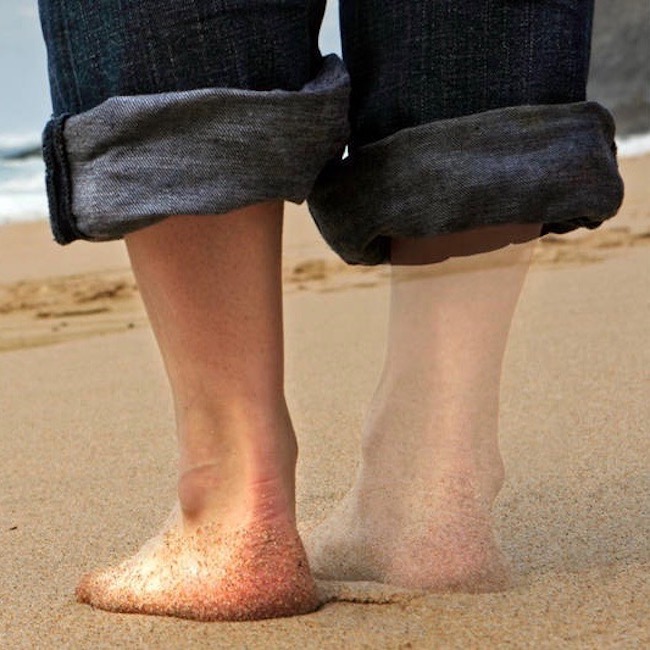
Image A
History: Understand that PLS is not new; it was first described almost 500 years ago by the brilliant French surgeon, Ambroise Paré. Paré operated on wounded soldiers and wrote in detail about patients who complained of pain in amputated limbs (Image B). Just so you know, Paré came up with such inspired and innovative surgeries to cope with physical trauma, he earned the sobriquet, the Father of Modern Surgery!
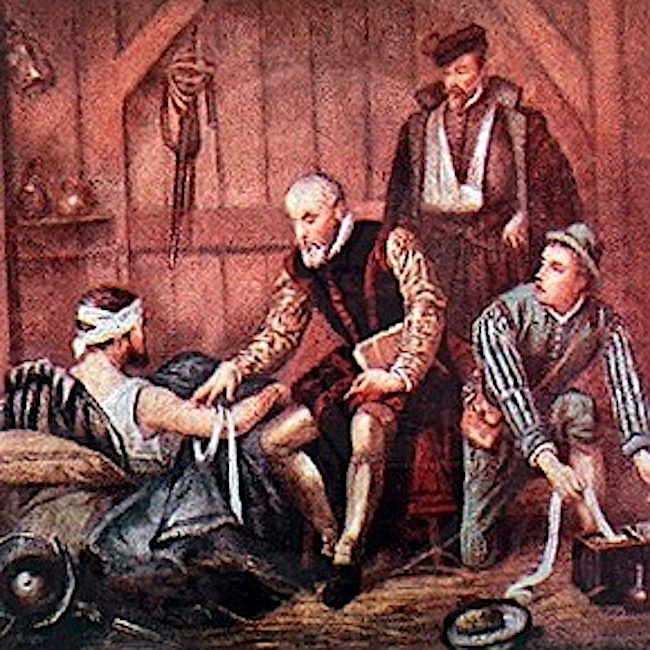
Image B
Herself does a fine job explaining phantom limb syndrome. Here, a quote from Voyager book, albeit from much later in the voyage! <G>
Innes came voluntarily to call upon me in my cabin a week later. “I am wondering, mistress,” he said politely, “whether there might be a medicine for something as isna there.” “What?” I must have looked puzzled at this description, for he lifted the empty sleeve of his shirt in illustration. “My arm,” he explained. “It’s no there, as ye can plainly see. And yet it pains me something terrible sometimes.” He blushed slightly. “I did wonder for some years was I only a bit mad,” he confided, in lowered tones. “But I spoke a bit wi’ Mr. Murphy, and he tells me it’s the same with his leg that got lost, and Fergus says he wakes sometimes, feeling his missing hand slide into someone’s pocket.” … “So I thought maybe if it was a common thing, to feel a limb that wasn’t there, perhaps there was something that might be done about it.”
“I see.” I rubbed my chin, pondering.“Yes, it is common; it’s called a phantom limb, when you still have feelings in a part that’s been lost. As for what to do about it.…”
Back to the lesson! So sorry, but the next three slides and accompanying text are dense with new words and concepts. No way around it, so please hang in there!
Phantom Limb Pain (PLP): People with PLS report sensations in the missing part including itching, motion, burning, gesturing, tickling, pain, etc. Sadly, pain is by far the most common experience. For some amputees, PLP is intermittent and the frequency and intensity of attacks may decline over time. With others, limb loss leads to debilitating pain. Although theories are plentiful, scientists have not been able to fully explain PLP.
You might recall this fellow from yesterday’s teaser (Image C)? This is the sensory homunculus (i.e. very small humanoid creature). Weird looking, it is a visual representation of sensations the brain recognizes from different areas of the body. Understanding the homunculus will help us understand the theories used to explain PLS and PLP.
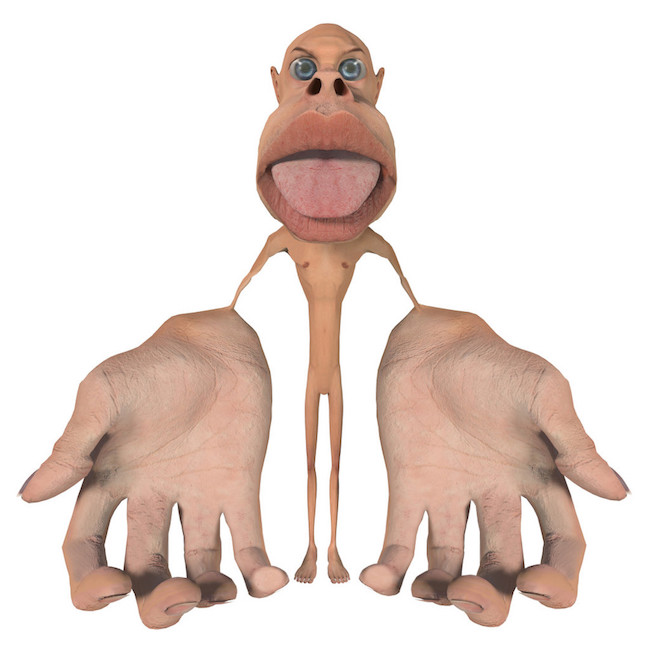
Image C
Sensory Homunculus: Scientists do know this (short and sweet): The entire human body, excepting brain and spinal cord (go figure!), is supplied with specialized sensory receptors. When stimulated, these receptors send signals to brain cells (neurons) of the sensory cortex (Image D – pink strips). Here, incoming sensory signals are interpreted as pain, heat, cold, touch, pressure, vibration, etc. There is a sensory cortex for the right side of body and one for the left.
And, just to be thorough, a similar adjacent area (Image D – green strip), the motor cortex, contains motor neurons which send outgoing signals to skeletal muscles, stimulating them to contract. Same for the motor cortex: one for the right side and for the left side of body.
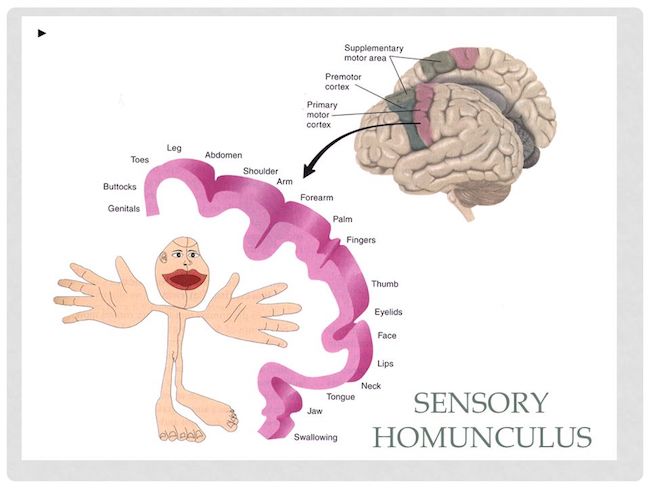
Sensory Homunculus (cont.): Those signals sent by sensory receptors are carried to prescribed areas of the sensory cortex based on their origin. Thus, if nerve endings in the great toe are stimulated, these signals end up in the area of the sensory cortex assigned to the big toe. If signals originate at the tongue, they end up in the sensory cortex assigned to the tongue. Ergo, the entire body is mapped out in the sensory cortex so signals are directed to their proper destination.
Such a sensory map assumes the shape of a small human and hence the term, sensory homunculus. BTW, the enlarged face, hands and feet (and genitals, which for the sake of sensitivity are not shown) aren’t meant for humor, these simply indicate anatomical areas with the greatest number/density of sensory receptors (Image E).
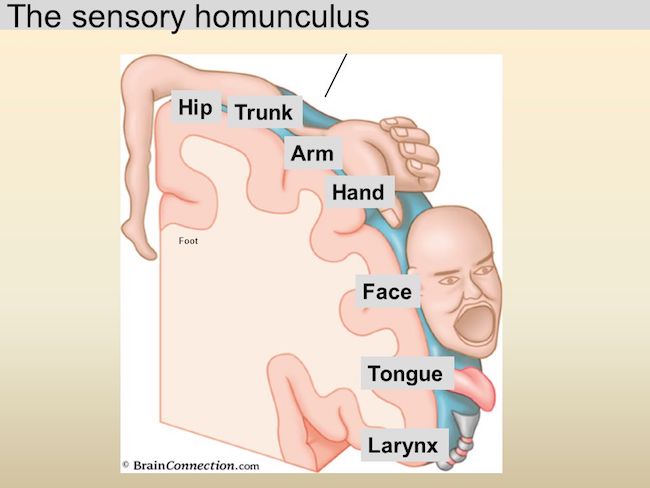
Image E
Theories: All of this sensory cortex business produces theories designed to explain phantom limb syndrome.
The bottom line? Scientists have yet to prove which if any of these theories are correct. Perhaps each possesses a piece of the puzzle? Much research is being focused on this issue because there are far more amputees in today’s western world due to war.
The following is an excellent video quickly explaining PLS and PLP. Unfortunately, it doesn’t stop at the end and other videos begin to p lay. Just click on the stop bars to halt it. Hope you watch, anyway!
Back to Outlander: When TV Claire first encounters the tragedy of Fergus’ hand, he has adopted an 18th century prosthesis (Starz ep 307, A. Malcolm) to help compensate for his loss.
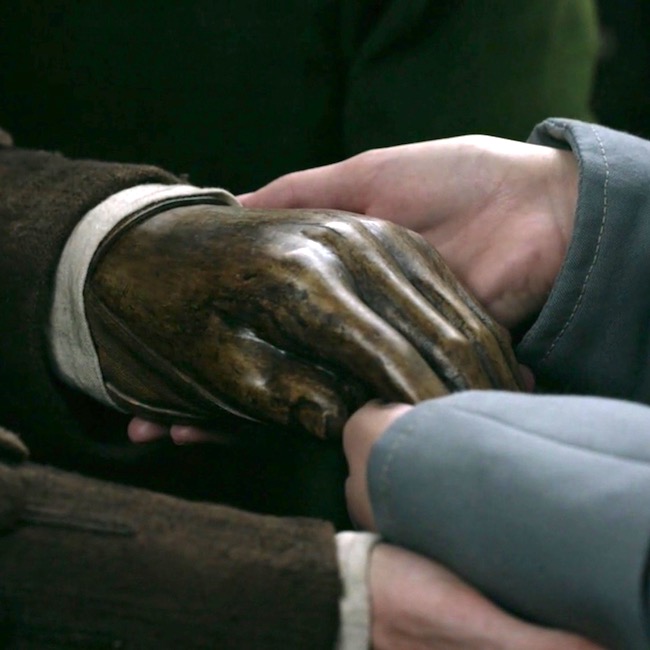
And, Marsali, aboard the Artemis, gives us a clue that TLC can be a big comfort to an amputee (Starz ep 309, The Doldrums)!
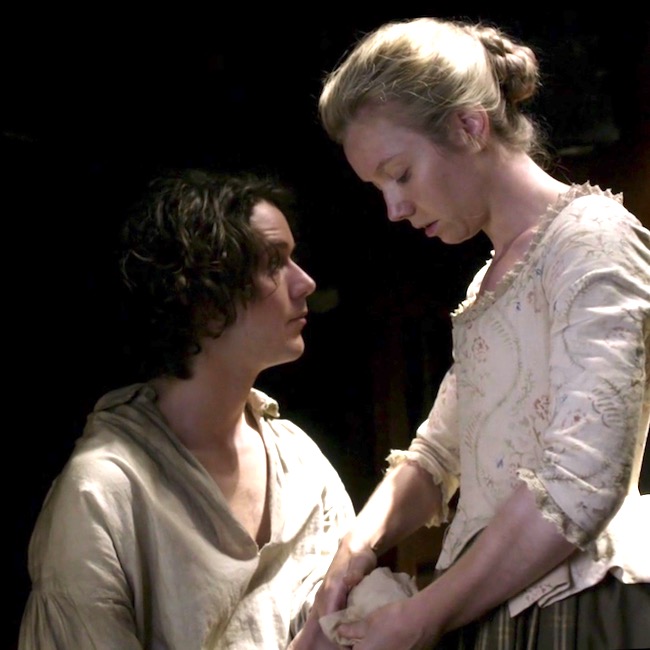
PLS Treatments: Today, there is hope as medical treatments for PLS and PLP are varied and imaginative! These include:
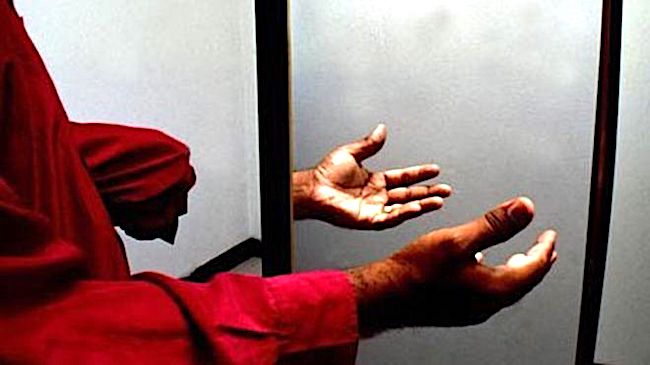
Image F
Swift and to the point, but the above pretty info much summarizes the current state of PLS and PLP research. OK, enough neuroscience. Back to Outlander!
Special Effects: I cannot let this pass unnoticed! How do you rate the special effects of Outlander ep 302, Surrender? Thumbs up? Thumbs down? I give two thumbs up! Here’s three good reasons why.
Make sense? Awesome sauce! Way to go, Outlander team!
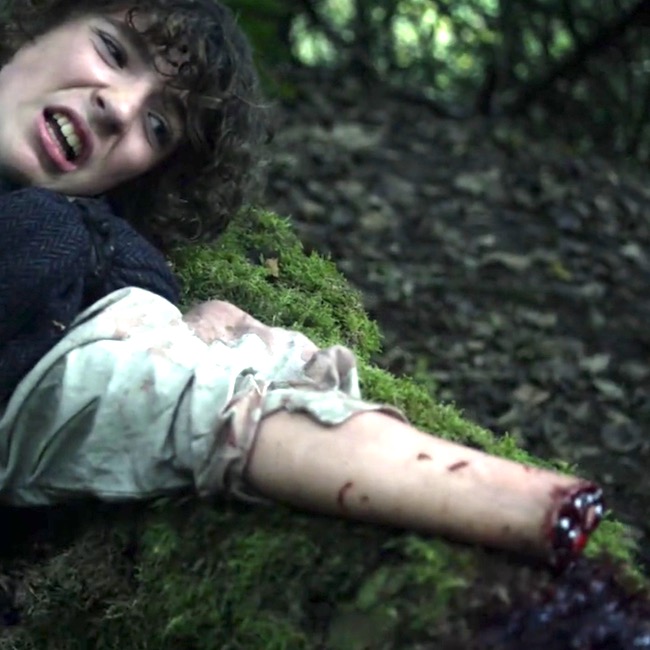
Hopefully, you learned something new in this lesson. Wish the definitive answer to PLS and PLP was available but research continues, unabated.
Let us close this lesson with a verra fine example of neuroplasticity!
Two hundred and two years and thousands of miles away, Claire experiences her own type of phantom pain! Missing her heart, she visualizes the core of her loss (Outlander episode 302, Surrender). Phantom, indeed! Hehe….

The deeply grateful,
Outlander Anatomist
Follow me on:
Photo creds: Sony/Starz; www.painresource.com (Image A); www.robotspacebrain.com (Image B); www.gravitywerks.com (Image C); www.slideplayer.com (Image D, E); www.bbc.com (Image F)